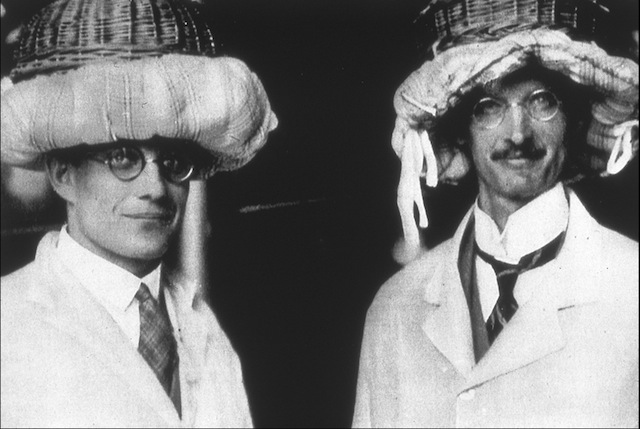
Auguste Piccard (right) and his assistant Paul Kipfer prepare to enter the Stratosphere, photo: Bundesarchiv, Bild 102-11505 / CC-BY-SA 3.0, CC BY-SA 3.0 DE, via Wikimedia Commons (cropped)
On 18 August 1932, launched from Dübendorf, Switzerland, August Piccard and Max Cosyns made a record-breaking ascent to 16,200 m. Scientists and explorers we are, to boldly go where no man has gone before. If there is one scientist, who might serve as the prototype of a bold explorer, then we have to consider Auguste Piccard, who tried to explore the deepest depths of the sea as well as the extreme stratosphere of the earth. And he did this not only in theory, but by experiment (always including his own person).
Auguste Piccard – Biographical Background
Piccard and his twin brother Jean Felix Piccard were born in Basel on January 28, 1884. Their father was the chemist Jules Piccard, their mother Hélène Haltenhoff. Piccard graduated as a mechanical engineer from the Polytechnic in Zurich (later the ETH) in 1910, followed by a doctorate in 1913. In 1915 Piccard became a private lecturer, in 1917 he was appointed professor of mechanics and from 1920 of physics at the ETH. In 1922 he was appointed to the University of Brussels, where he taught until his retirement in 1954.
Researching the Upper Atmosphere
After world war I in 1917 Piccard discovered a new Uranium isotope Actinuran (today referred to as Uranium 235). After his appointment of professor of physics at the Polytechnic School of Brussels in 1922, he tried first test flights of stratospheric free balloons. An important motivation for Piccard’s ascents into the upper atmosphere was the possibility of measuring cosmic rays there. Piccard wanted to gather experimental evidence for the theories of his friend Albert Einstein. Like Piccard, Einstein had studied at the ETH. They met at the legendary 5th Solvay Conference in 1927, which brought together the most important physicists of the time in the fields of relativity, atomic and quantum physics. Piccard’s balloon ascents were theoretically prepared in collaboration with Albert Einstein and were actually able to successfully prove part of the special theory of relativity experimentally
“As to rocket ships flying between America and Europe, I believe it is worth seriously trying for. Thirty years ago persons who were developing flying were laughed at as mad, and that scorn hindered aviation. Now we heap similar ridicule upon stratoplane or rocket ships for trans-Atlantic flights.” — Auguste Piccard
Breaking Records – The First Astronaut
In 1930, his curiosity about the upper atmosphere and his interest in ballooning led him to design a spherical, pressurized aluminum gondola that would allow ascent to great altitude without requiring a pressure suit. On 27 May 1931, Auguste Piccard and Paul Kipfer took off from Augsburg, Germany, and reached a record altitude of 15,785 m. During this flight, Piccard was able to gather substantial data on the upper atmosphere, as well as measure cosmic rays. On 18 August 1932, launched from Dübendorf, Switzerland, Piccard and Max Cosyns made a second record-breaking ascent to 16,200 m . He ultimately made a total of twenty-seven balloon flights, setting a final record of 23,000 m (75,459 ft). By reaching the upper atmosphere, Auguste Piccard might also be referred to as the very first astronaut.
The Depths of the Oceans
In the mid-1930s, Piccard’s interests shifted when he realized that a modification of his high altitude balloon cockpit would allow descent into the deep ocean. Following the same principle as his pressurized balloon gondola, in 1937 he constructed a deep sea diving vehicle, called the Bathyscaphe, a small steel gondola built to withstand great external pressure. Work started in 1937 but was interrupted by World War II. The deep-diving submarine finally was finished in 1948. It made a number of unmanned dives in 1948 before being given to the French Navy in 1950. Together with his son Jacques, Auguste Piccard undertook a redesign of the Bathyscape and in September 30, 1953 both set a dive record with 3150 meters depth at Ponza in the Tyrrhenian Sea. On 23 January 1960, Jacques Piccard together with US Navy Lt. Don Walsh reached the floor of the Mariana Trench located in the western North Pacific Ocean with the Bathyscape Triest. The depth of the descent was measured at 10,916 meters (35,813 feet).
Atomic Physics
In addition to his groundbreaking stratospheric and deep diving experiments, Piccard also dealt with atomic physics. He predicted the existence of a third uranium isotope in 1917, which he called Actinuran. It was discovered in 1937 by Arthur Jeffrey Dempster and identified as uranium-235 Among other things, Piccard constructed the most accurate seismograph at the time.
As a mater of fact there are several references of Prof. Auguste Piccard in popular media. He was the inspiration for Professor Cuthbert Calculus in The Adventures of Tintin by Belgian cartoonist Hergé.[8] Moreover, also the name of Start Trek – Next Generation Captain Jean-Luc Picard stems from Auguste Piccard.
Auguste Piccard died on 24 March 1962 of a heart attack at his home in Lausanne, Switzerland, he was 78 years old
Professor Piccard talking about mankind in the stratosphere, [4]
References and Further Reading:
- [1] Auguste Piccard at Britannica Online
- [2] “Ten Miles High in an Air-Tight Ball“, Popular Science, 1931
- [3] Auguste Piccard at Wikidata
- [4] Professor Piccard talking about mankind in the stratosphere, iconic @ youtube
- [5] More than just hot air – the Montgolfier-Balloons, SciHi Blog
- [6] The Adventures of Sir Richard Francis Burton in Africa, SciHi Blog
- [7] Salomon August Andrée’s Ill Fated Polar Balloon Expedition, SciHi Blog
- [8] Hergé and the Fabulous Adventures of Tintin, SciHi Blog
- [9] “Auguste Piccard, Explorer, Is Dead. Auguste Piccard Is Dead at 78. Stratosphere and Sea Explorer”. The New York Times. 26 March 1962.
- [10] Auguste Piccard Timeline via Wikidata






Pingback: Whewell’s Gazette: Year 2, Vol. #06 | Whewell's Ghost